3.5 The Development and Evolution of Nervous Systems
The human brain is surprisingly imperfect. Why? Far from being a single, elegant machine—
To understand the central nervous system, it is helpful to consider two aspects of its development. Prenatal development (growth from conception to birth), reveals how the nervous system develops and changes within each member of a species. Evolutionary development reveals how the nervous system in humans evolved and adapted from other species.
Prenatal Development of the Central Nervous System
What are the stages of development of the embryonic brain?
The nervous system is the first major bodily system to take form in an embryo (Moore, 1977). It begins to develop within the 3rd week after fertilization, when the embryo is still in the shape of a sphere. Initially, a ridge forms on one side of the sphere and then builds up at its edges to become a deep groove. The ridges fold together and fuse to enclose the groove, forming a structure called the neural tube. The tail end of the neural tube will remain a tube, and as the embryo grows larger, it forms the basis of the spinal cord. The tube expands at the opposite end, so that by the 4th week the three basic levels of the brain are visible. During the 5th week, the forebrain and hindbrain further differentiate into subdivisions. During the 7th week and later, the forebrain expands considerably to form the cerebral hemispheres.

 Figure 3.20: Prenatal Brain Development The more primitive parts of the brain, the hindbrain and midbrain, develop first, followed by successively higher levels. The cerebral cortex with its characteristic fissures doesn’t develop until the middle of the pregnancy. The cerebral hemispheres undergo most of their development in the final trimester.
Figure 3.20: Prenatal Brain Development The more primitive parts of the brain, the hindbrain and midbrain, develop first, followed by successively higher levels. The cerebral cortex with its characteristic fissures doesn’t develop until the middle of the pregnancy. The cerebral hemispheres undergo most of their development in the final trimester.
As the embryonic brain continues to grow, each subdivision folds onto the next one and begins to form the structures easily visible in the adult brain (see FIGURE 3.20). The hindbrain forms the cerebellum and medulla, the midbrain forms the tectum and the tegmentum, and the forebrain subdivides further, separating the thalamus and hypothalamus from the cerebral hemispheres. Over time, the cerebral hemispheres undergo the greatest development, ultimately covering almost all the other subdivisions of the brain.
The ontogeny of the brain (how it develops within a given individual) is pretty remarkable. In about half the time it takes you to complete a 15-
107
Evolutionary Development of the Central Nervous System
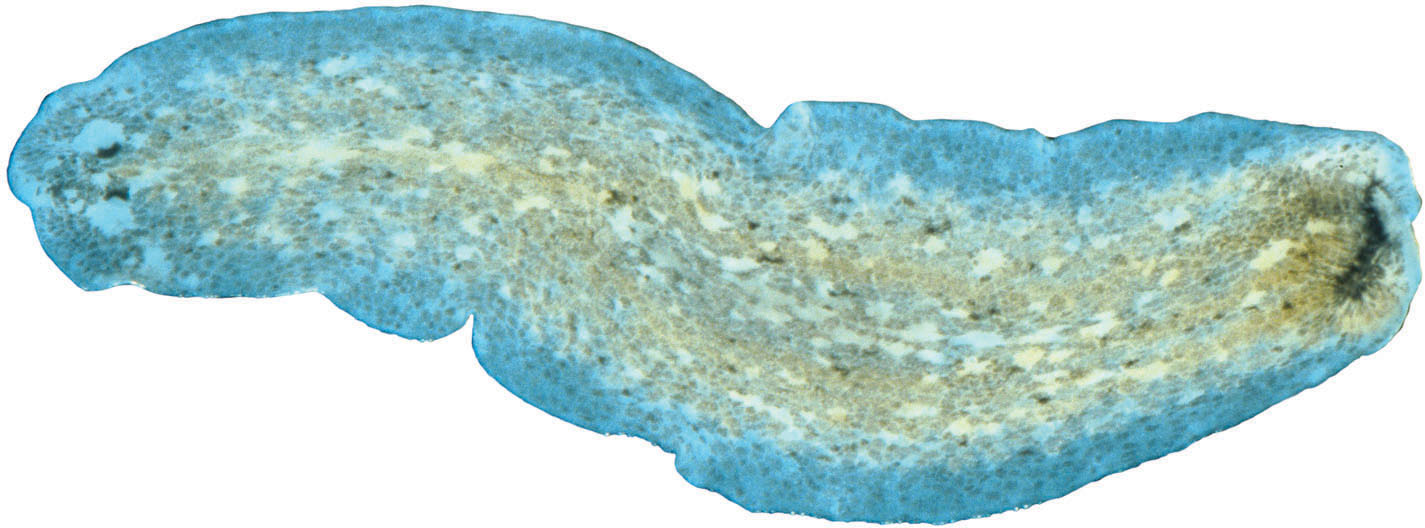
The central nervous system evolved from the very simple one found in simple animals to the elaborate nervous system in humans today. Even the simplest animals have sensory neurons and motor neurons for responding to the environment (Shepherd, 1988). For example, single-
During the course of evolution, a major split in the organization of the nervous system occurred between invertebrate animals (those without a spinal column) and vertebrate animals (those with a spinal column). In all vertebrates, the central nervous system is organized into a hierarchy: The lower levels of the brain and spinal cord execute simpler functions, while the higher levels of the nervous system perform more complex functions. As you saw earlier, in humans, reflexes are accomplished in the spinal cord. At the next level, the midbrain executes the more complex task of orienting toward an important stimulus in the environment. Finally, a more complex task, such as imagining what your life will be like 20 years from now, is performed in the forebrain (Addis, Wong, & Schacter, 2007; Schacter, Addis, et al., 2012; Szpunar, Watson, & McDermott, 2007).
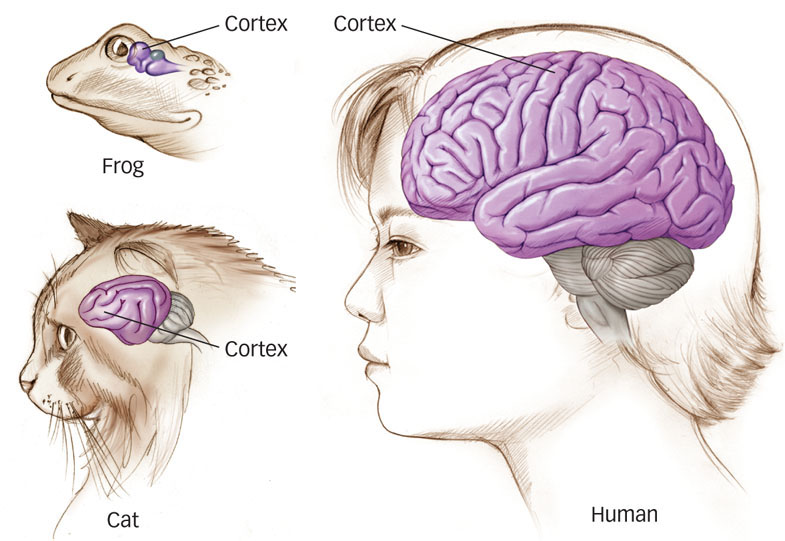
 Figure 3.21: Development of the Forebrain Reptiles and birds have almost no cerebral cortex, whereas mammals such as rats and cats do have a cerebral cortex, but their frontal lobes are proportionately much smaller than the frontal lobes of humans and other primates. How might this explain the fact that only humans have developed complex language, computer technology, and calculus?
Figure 3.21: Development of the Forebrain Reptiles and birds have almost no cerebral cortex, whereas mammals such as rats and cats do have a cerebral cortex, but their frontal lobes are proportionately much smaller than the frontal lobes of humans and other primates. How might this explain the fact that only humans have developed complex language, computer technology, and calculus?
The forebrain undergoes further evolutionary advances in vertebrates. In lower vertebrate species such as amphibians (frogs and newts), the forebrain consists only of small clusters of neurons at the end of the neural tube. In higher vertebrates, including reptiles, birds, and mammals, the forebrain is much larger, and it evolves in two different patterns. Reptiles and birds have almost no cerebral cortex. By contrast, mammals have a highly developed cerebral cortex, which develops multiple areas that serve a broad range of higher mental functions. This forebrain development has reached its peak—
The human brain, then, is not so much one remarkable thing; rather, it is a succession of extensions from a quite serviceable foundation. Like other species, humans have a hindbrain, and like those species, it performs important tasks to keep us alive. For some species, that’s sufficient. All flatworms need to do to ensure their species’ survival is eat, reproduce, and stay alive a reasonable length of time. But as the human brain evolved, structures in the midbrain and forebrain developed to handle the increasingly complex demands of the environment. The forebrain of a bullfrog is about as differentiated as it needs to be to survive in a frog’s world. The human forebrain, however, shows substantial refinement, which allows for some remarkable, uniquely human abilities: self-
108
Are our brains still evolving?
There is intriguing evidence that the human brain evolved more quickly than the brains of other species (Dorus et al., 2004). Researchers compared the sequences of 200 brain-
Genes may direct the development of the brain on a large, evolutionary scale, but they also guide the development of an individual and, generally, the development of a species. Let’s take a brief look at how genes and the environment contribute to the biological bases of behavior.
Genes, Epigenetics, and the Environment
Is it genetics (nature) or the environment (nurture) that reigns supreme in directing a person’s behavior? The emerging picture from current research is that both nature and nurture play a role in directing behavior, and the focus has shifted to examining the interaction of the two rather than the absolute contributions of either alone (Gottesman & Hanson, 2005; Rutter & Silberg, 2002; Zhang & Meaney, 2010).
What Are Genes?
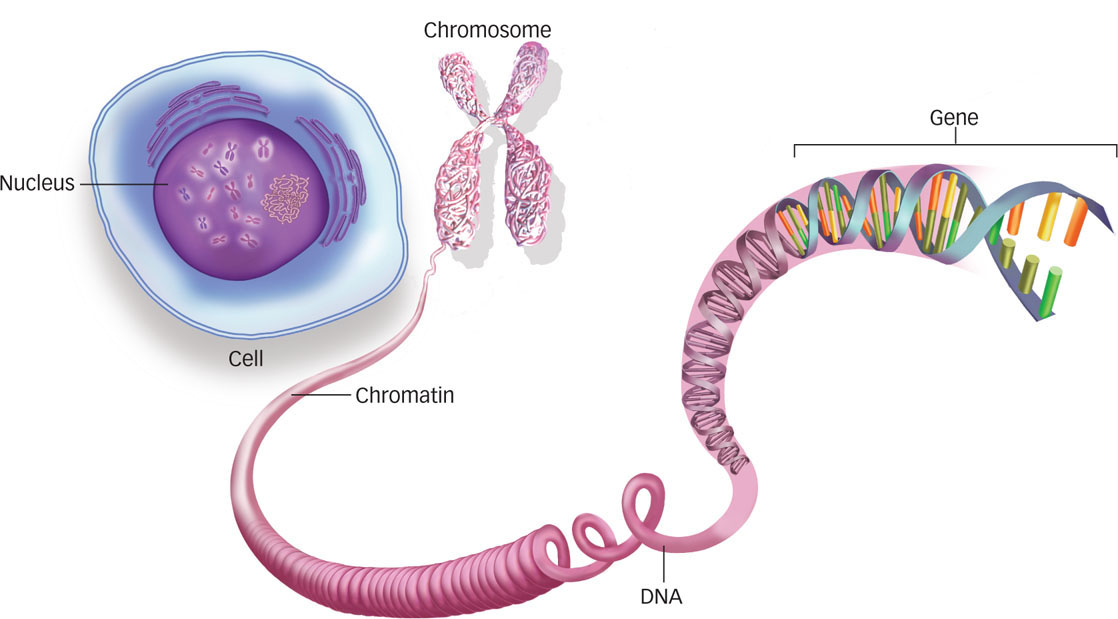
 Figure 3.22: Genes, Chromosomes, and Their Recombination The cell nucleus houses chromosomes, which are made up of double-
Figure 3.22: Genes, Chromosomes, and Their Recombination The cell nucleus houses chromosomes, which are made up of double-gene The major unit of hereditary transmission.
A gene is the major unit of hereditary transmission. Historically, the term gene has been used to refer to two distinct but related concepts. The initial, relatively abstract concept of a gene referred to units of inheritance that specify traits such as eye color. More recently, genes have been defined as sections on a strand of DNA (deoxyribonucleic acid) that code for the protein molecules that affect traits. Genes are organized into large threads called chromosomes, strands of DNA wound around each other in a double-
chromosomes Strands of DNA wound around each other in a double-
Perhaps the most striking example of this random distribution is the determination of sex. In mammals, the chromosomes that determine sex are the X and Y chromosomes; females have two X chromosomes, whereas males have one X and one Y chromosome. You inherited an X chromosome from your mother because she has only X chromosomes to give. Your biological sex, therefore, was determined by whether you received an additional X chromosome or a Y chromosome from your father.
As a species, we share about 99% of the same DNA (and almost as much with other apes), but there is a portion of DNA that varies across individuals. Children share more of this variable portion of DNA with their parents than with more distant relatives or with nonrelatives: They share half their genes with each parent, a quarter of their genes with their grandparents, an eighth of their genes with cousins, and so on. The probability of sharing genes is called degree of relatedness. The most genetically related people are monozygotic twins (also called identical twins), who develop from the splitting of a single fertilized egg and therefore share 100% of their genes. Dizygotic twins (fraternal twins) develop from two separate fertilized eggs and share 50% of their genes, the same as any two siblings born separately.
109
Many researchers have tried to determine the relative influence of genetics on behavior. One way to do this is to compare a trait shown by monozygotic twins with that same trait among dizygotic twins. This type of research usually enlists twins who were raised in the same household, so that the impact of their environment (their socioeconomic status, access to education, parental child-
Why do dizygotic twins share 50% of their genes, just like siblings born separately?
As an example, the likelihood that the dizygotic twin of a person who has schizophrenia (a mental disorder we’ll discuss in greater detail in the Psychological Disorders chapter) will also develop schizophrenia is 27%. However, this statistic rises to 50% for monozygotic twins. This observation suggests a substantial genetic influence on the likelihood of developing schizophrenia. Monozygotic twins share 100% of their genes, and if one assumes environmental influences are relatively consistent for both members of the twin pair, the 50% likelihood can be traced to genetic factors. That sounds scarily high…until you realize that the remaining 50% probability must be due to environmental influences. In short, genetics can contribute to the development, likelihood, or onset of a variety of traits. But a more complete picture of genetic influences on behavior must always take the environmental context into consideration. Genes express themselves within an environment, not in isolation.

JBPHOTO1/ALAMY
110
A Role for Epigenetics
epigenetics Environmental influences that determine whether or not genes are expressed, or the degree to which they are expressed, without altering the basic DNA sequences that constitute the genes themselves.
The idea that genes are expressed within an environment is central to an important and rapidly growing area of research known as epigenetics: environmental influences that determine whether or not genes are expressed, or the degree to which they are expressed, without altering the basic DNA sequences that constitute the genes themselves. To understand how epigenetic influences work, it is useful to think about DNA as analogous to a script for a play or a movie. The biologist Nessa Carey (2012) offers the example of Shakespeare’s Romeo and Juliet, which was made into a movie back in 1936 starring classic actors Leslie Howard and Norma Shearer, and in 1996 starring Leonardo DiCaprio and Claire Danes. Shakespeare’s script formed the basis of both films, but the directors of the two films used the script in different ways, and the actors in the two films gave different performances. Thus, the final products departed from Shakespeare’s script and were different from one another, even though Shakespeare’s original script still exists. Something similar happens with epigenetics: depending on the environment, a gene can be expressed or not without altering the underlying DNA code.
epigenetic marks Chemical modifications to DNA that can turn genes on or off.
The environment can influence gene expression through epigenetic marks, chemical modifications to DNA that can turn genes on or off. You can think of epigenetic marks as analogous to notes that the movie directors made on Shakespeare’s script that determined how the script was used in a particular film. There are two widely studied epigenetic marks:
 DNA methylation refers to adding a methyl group to DNA. There are special enzymes, referred to as epigenetic writers, whose role is to add methyl groups to DNA. Although adding a methyl group doesn’t alter the basic DNA sequence, it switches off the methylated gene (see FIGURE 3.23). This process is roughly analogous to Claire Danes’ director making notes that instruct her to ignore a certain portion of the Shakespeare script. That portion of the script—
DNA methylation refers to adding a methyl group to DNA. There are special enzymes, referred to as epigenetic writers, whose role is to add methyl groups to DNA. Although adding a methyl group doesn’t alter the basic DNA sequence, it switches off the methylated gene (see FIGURE 3.23). This process is roughly analogous to Claire Danes’ director making notes that instruct her to ignore a certain portion of the Shakespeare script. That portion of the script—like the switched off gene— is still there, but its contents are not expressed. DNA methylation Adding a methyl group to DNA.
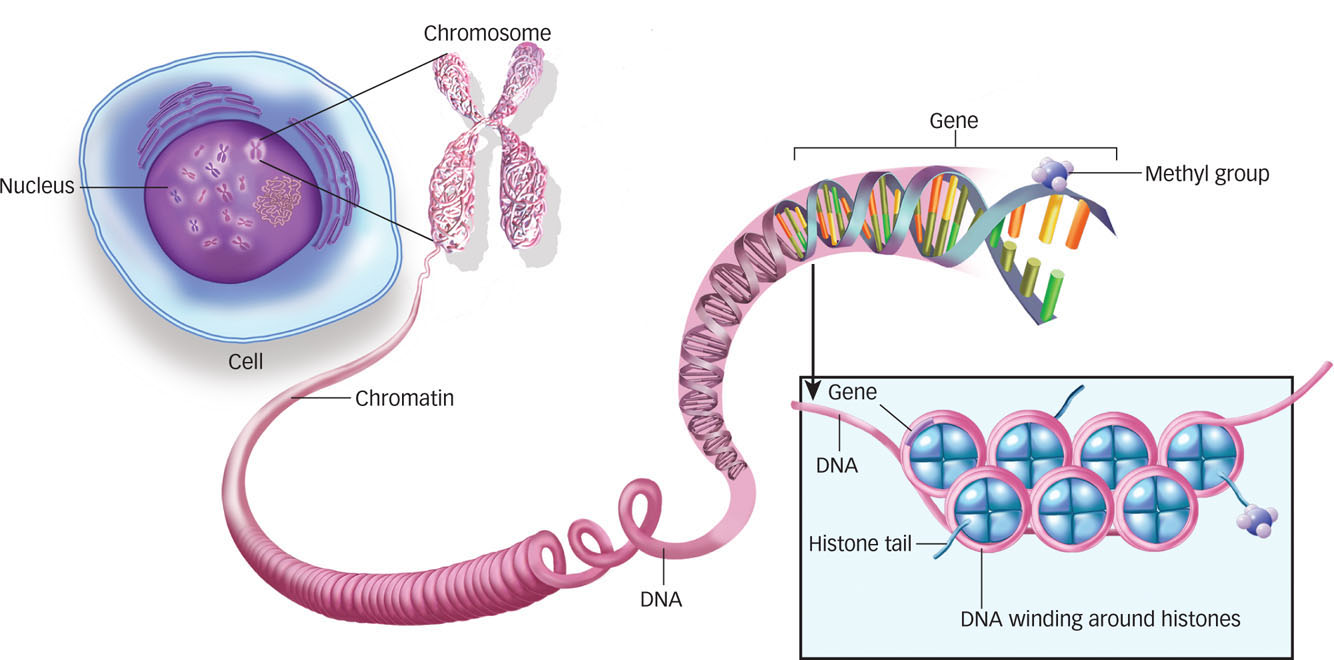
 Figure 3.23: Epigenetics Studies suggest that DNA methylation and histone modification play a key role in the long-
Figure 3.23: Epigenetics Studies suggest that DNA methylation and histone modification play a key role in the long-lasting effects of early life experiences for both rodents and humans.  Histone modification involves adding chemical modifications to proteins called histones that are involved in packaging DNA. We tend to visualize DNA as the free-
Histone modification involves adding chemical modifications to proteins called histones that are involved in packaging DNA. We tend to visualize DNA as the free-floating double helix shown in Figure 3.22, but DNA is actually tightly wrapped around groups of histone proteins, as shown in Figure 3.23. However, whereas DNA methylation serves to switch genes off, histone modification can either switch genes off or turn them on. But just like DNA methylation, histone modifications influence gene expression without altering the underlying DNA sequence (Carey, 2012). histone modification Adding chemical modifications to proteins called histones that are involved in packaging DNA.
Okay, so now you have learned a lot of strange new terms and may have wondered whether Claire Danes’ performance in Romeo and Juliet prepared her to play Carrie in Homeland (come to think of it, Carrie’s relationship with Brody bears some resemblance to Shakespeare’s doomed lovers). But what is the relevance of epigenetics to the brain and to psychology? It turns out to be more relevant than anyone suspected until the past decade or so. Experiments with rats and mice have shown that epigenetic marks left by DNA methylation and histone modifcation play a role in learning and memory (Bredy et al., 2007; Day & Sweatt, 2011; Levenson, & Sweatt, 2005). Several studies have linked epigenetic changes with responses to stress (Zhang & Meaney, 2010), including recent research with humans. For example, studies of nurses working in high-
111
The Role of Environmental Factors
Genes set the range of possibilities that can be observed in a population, but the characteristics of any individual within that range are determined by environmental factors and experience. The genetic capabilities that another species might enjoy, such as breathing underwater, are outside the range of your possibilities, no matter how much you might desire them.
heritability A measure of the variability of behavioral traits among individuals that can be accounted for by genetic factors.
With these parameters in mind, behavioral geneticists use calculations based on relatedness to compute the heritability of behaviors (Plomin, DeFries, et al., 2001). Heritability is a measure of the variability of behavioral traits among individuals that can be accounted for by genetic factors. Heritability is calculated as a proportion, and its numerical value (index) ranges from 0 to 1.00. A heritability of 0 means that genes do not contribute to individual differences in the behavioral trait; a heritability of 1.00 means that genes are the only reason for the individual differences. As you might guess, scores of 0 or 1.00 occur so infrequently that they serve more as theoretical limits than realistic values; almost nothing in human behavior is completely due to the environment or owed completely to genetic inheritance. Scores between 0 and 1.00, then, indicate that individual differences are caused by varying degrees of genetic and environmental contributions—
112
HOT SCIENCE: Epigenetics and the Persisting Effects of Early Experiences
An exciting series of studies show that epigenetic processes play a critical role in the long-
Let’s first consider early work from Meaney’s lab that provides critical background (Francis et al., 1999; Liu et al., 1997). This work was based on the finding that there are notable differences in the mothering styles of rats: Some mothers spend a lot of time licking and grooming their young pups (high LG mothers), which rat pups greatly enjoy, whereas others spend little time doing so (low LG mothers). The researchers found that pups of high LG mothers are much less fearful as adults when placed in stressful situations than the adult pups of low LG mothers. Perhaps this simply reflects the effects of a genetic profile shared by the mother and her pups? Not so. Meaney and colleagues demonstrated that the same effects are obtained when the offspring of high LG mothers are raised by low LG mothers, and vice versa. These effects were accompanied by physiological changes. When placed in fear-

Meaney’s group examined hippocampal samples taken from the brains of 24 men who had committed suicide around the age of 35 (McGowan et al., 2009). (The hippocampus plays a role in response to stress and has the highest concentration glucocorticoid receptions in the entire brain.) Twelve of those men had a history of childhood abuse and 12 did not. The researchers compared their hippocampal samples to a separate control group of 12 men who had died suddenly at around the same age but had no history of abuse and had not committed suicide. Strikingly, they found evidence for increased levels of DNA methylation at the hippocampal glucocorticoid receptor gene in the 12 men who had suffered childhood abuse and committed suicide compared with the 12 men in the control group. But they found no such differences between the 12 men who committed suicide but had not been abused and the 12 men in the control group. Increased DNA methylation reduced expression of the glucocorticoid receptor gene in the 12 victims of childhood abuse, just as in the adult pups of low LG mothers. Although this research doesn’t tell us whether or how differences in DNA methylation were related to the behaviors of the abused and non-
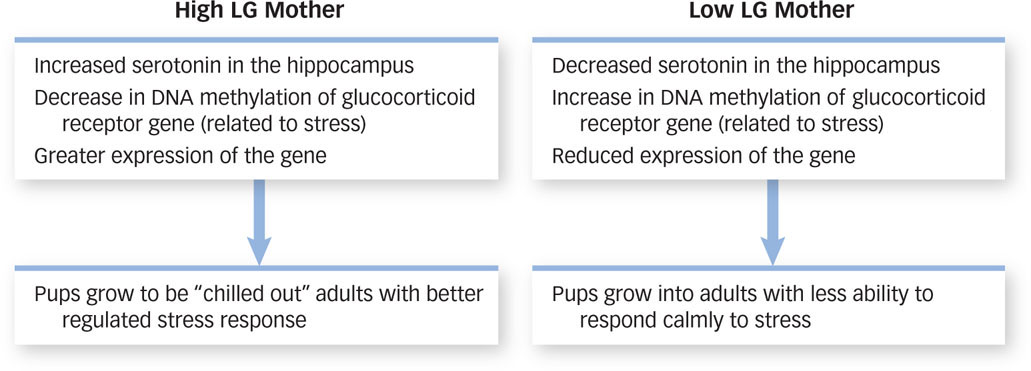
Studies suggest that the effects of early experience are not restricted to a single gene, but occur more broadly. A more recent study of rats from Meaney’s lab demonstrates hundreds of DNA methlyation differences in the hippocampus of the offspring of high and low LG mothers (McGowan et al., 2011). New analyses of hippocampal samples from abused suicide victims also reveal widespread DNA methylation differences between the abused sample and a control group of non-
113
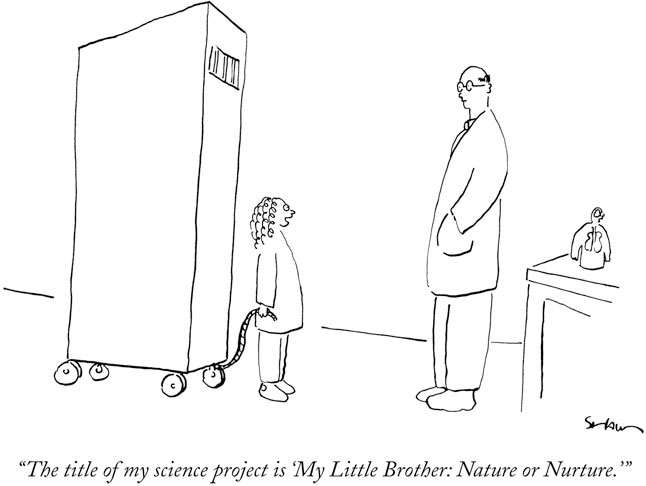
For human behavior, almost all estimates of heritability are in the moderate range, between .30 and .60. For example, a heritability index of .50 for intelligence indicates that half of the variability in intelligence test scores is attributable to genetic influences and the remaining half is due to environmental influences. Smart parents often (but not always) produce smart children; genetics certainly plays a role. But smart and not-
Are abilities, such as intelligence and memory, inherited through our genes?
Heritability has proven to be a theoretically useful and statistically sound concept in helping scientists understand the relative genetic and environmental influences on behavior. However, there are four important points about heritability to bear in mind. First, remember that heritability is an abstract concept: It tells us nothing about the specific genes that contribute to a trait. Second, heritability is a population concept: It tells us nothing about an individual. Heritability provides guidance for understanding differences across individuals in a population rather than abilities within an individual.
Third, heritability is dependent on the environment. Just as behavior occurs within certain contexts, so do genetic influences. For example, intelligence isn’t an unchanging quality: People are intelligent within a particular learning context, a social setting, a family environment, a socioeconomic class, and so on. Heritability, therefore, is meaningful only for the environmental conditions in which it was computed, and heritability estimates may change dramatically under other environmental conditions. Finally, heritability is not fate. It tells us nothing about the degree to which interventions can change a behavioral trait. Heritability is useful for identifying behavioral traits that are influenced by genes, but it is not useful for determining how individuals will respond to particular environmental conditions or treatments.
 Examining the development of the nervous system over the life span of an individual (its ontogeny) and across the time within which a species evolves (its phylogeny) presents further opportunities for understanding the human brain.
Examining the development of the nervous system over the life span of an individual (its ontogeny) and across the time within which a species evolves (its phylogeny) presents further opportunities for understanding the human brain. The nervous system is the first system that forms in an embryo, starting as a neural tube, which forms the basis of the spinal cord. The neural tube expands on one end to form the hindbrain, midbrain, and forebrain, each of which folds onto the next structure.
The nervous system is the first system that forms in an embryo, starting as a neural tube, which forms the basis of the spinal cord. The neural tube expands on one end to form the hindbrain, midbrain, and forebrain, each of which folds onto the next structure. Within each of these areas, specific brain structures begin to differentiate. The forebrain shows the greatest differentiation, and in particular, the cerebral cortex is the most developed in humans.
Within each of these areas, specific brain structures begin to differentiate. The forebrain shows the greatest differentiation, and in particular, the cerebral cortex is the most developed in humans. Nervous systems evolved from simple collections of sensory and motor neurons in simple animals, such as flatworms, to elaborate centralized nervous systems found in mammals.
Nervous systems evolved from simple collections of sensory and motor neurons in simple animals, such as flatworms, to elaborate centralized nervous systems found in mammals. The evolution of the human nervous system can be thought of as a process of refining, elaborating, and expanding structures present in other species.
The evolution of the human nervous system can be thought of as a process of refining, elaborating, and expanding structures present in other species. Reptiles and birds have almost no cerebral cortex. By contrast, mammals have a highly developed cerebral cortex.
Reptiles and birds have almost no cerebral cortex. By contrast, mammals have a highly developed cerebral cortex. The human brain appears to have evolved more quickly compared to other species to become adapted to a more complex environment.
The human brain appears to have evolved more quickly compared to other species to become adapted to a more complex environment.
 The gene, or the unit of hereditary transmission, is built from strands of DNA in a double-
The gene, or the unit of hereditary transmission, is built from strands of DNA in a double-helix formation that is organized into chromosomes.  Humans have 23 pairs of chromosomes; half come from each parent.
Humans have 23 pairs of chromosomes; half come from each parent. A child shares 50% of his or her genes with each parent.
A child shares 50% of his or her genes with each parent. Monozygotic twins share 100% of their genes, whereas dizygotic twins share 50%, the same as any other siblings. Because of their genetic relatedness, twins are often participants in genetic research.
Monozygotic twins share 100% of their genes, whereas dizygotic twins share 50%, the same as any other siblings. Because of their genetic relatedness, twins are often participants in genetic research.
 The study of genetics indicates that both genes and the environment work together to influence behavior. Genes set the range of variation in populations within a given environment, but they do not predict individual characteristics; experience and other environmental factors play a crucial role as well.
The study of genetics indicates that both genes and the environment work together to influence behavior. Genes set the range of variation in populations within a given environment, but they do not predict individual characteristics; experience and other environmental factors play a crucial role as well. Epigenetics refers to environmental influences that determine whether or not genes are expressed, without altering the basic DNA sequences that constitute the genes themselves. Epigenetic marks such as DNA methylation and histone modification influence whether specific genes are switched on or off. Epigenetic influences have been shown to play a critical role in persisting effects of early experiences in rats and humans.
Epigenetics refers to environmental influences that determine whether or not genes are expressed, without altering the basic DNA sequences that constitute the genes themselves. Epigenetic marks such as DNA methylation and histone modification influence whether specific genes are switched on or off. Epigenetic influences have been shown to play a critical role in persisting effects of early experiences in rats and humans.